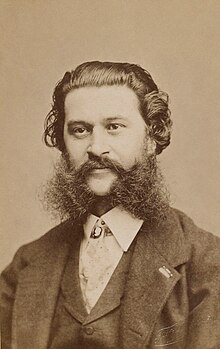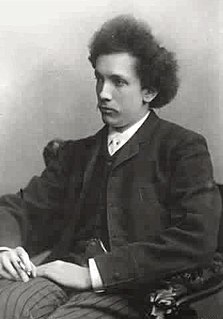Related Research Articles

Johann Baptist Strauss II, also known as Johann Strauss Jr., the Younger, the Son, was an Austrian composer of light music, particularly dance music and operettas. He composed over 500 waltzes, polkas, quadrilles, and other types of dance music, as well as several operettas and a ballet. In his lifetime, he was known as "The Waltz King", and was largely responsible for the popularity of the waltz in Vienna during the 19th century. Some of Johann Strauss's most famous works include "The Blue Danube", "Kaiser-Walzer", "Tales from the Vienna Woods", "Frühlingsstimmen", and the "Tritsch-Tratsch-Polka". Among his operettas, Die Fledermaus and Der Zigeunerbaron are the best known.

"The Blue Danube" is the common English title of "An der schönen, blauen Donau", Op. 314, a waltz by the Austrian composer Johann Strauss II, composed in 1866. Originally performed on 15 February 1867 at a concert of the Wiener Männergesang-Verein, it has been one of the most consistently popular pieces of music in the classical repertoire. Its initial performance was considered only a mild success, however, and Strauss is reputed to have said, "The devil take the waltz, my only regret is for the coda—I wish that had been a success!"

Joseph Franz Karl Lanner was an Austrian dance music composer and dance orchestra conductor. He is best remembered as one of the earliest Viennese composers to reform the waltz from a simple peasant dance to something that even the highest society could enjoy, either as an accompaniment to the dance, or for the music's own sake. He was just as famous as his friend and musical rival Johann Strauss I, who was better known outside of Austria in their day because of his concert tours abroad, in particular, to France and England.
Man lebt nur einmal! is a waltz by Johann Strauss II written in 1855. The piece was marked as im Ländlerstyle which in other words means "in the same style as the Ländler", which is an Austrian folk dance. The title was a quotation from Johann Wolfgang von Goethe's 1774 play Clavigo, but it raised a few eyebrows at that time as Vienna was just recovering from a disastrous cholera epidemic and many of the stricken populace may have been superstitious of such a title. Nonetheless, Strauss performed it at the Sperl Ballroom to great acclaim and this waltz has endured lasting appeal even in a simple string arrangement for a quintet consisting of two violins, one viola, one cello, and a double bass.
Wiener Frauen or 'Viennese Ladies' op. 423 is a waltz composed by Johann Strauss II in 1886.
'S gibt nur a Kaiserstadt, 's gibt nur a Wien! is a polka written by Johann Strauss II in 1864. The title of this polka was inspired from the waltz duet in the Singspiel Aline by Adolf Bäuerle with music by Wenzel Müller first performed at the Theater in der Leopoldstadt on 9 October 1822. The song titled 'Was macht denn der Prater' was a hit during its day whereas its refrain 'Ja nur ein' Kaiserstadt, ja nur a Wien' became a popular household phrase.
Nachtfalter (Moths) op. 157 is a waltz by Johann Strauss II written in 1854. The waltz was first performed at a parish festival ball at Unger's Casino in the suburb of Hernals, Vienna on 28 August of the same year.
Morgenblätter, Op. 279, is a Viennese waltz composed by Johann Strauss II in 1863 and first performed on 12 January 1864 at the Sofiensaal in Vienna. The work's genesis was attributed to the composition of a waltz by Jacques Offenbach later titled "Abendblätter" when the Offenbach dedicated his work to the influential Vienna Authors' and Journalists' Association. The association had earlier intended the "Abendblätter" waltz to be played at their Concordia Ball on 12 January 1864.
Im Krapfenwald'l op. 336 is a polka by Johann Strauss II written in 1869 and was originally titled 'Im Pawlowsk Walde' when first performed in Pavlovsk on 6 September 1869. Reportedly, several encores of the piece were called for and Strauss felt moved to retitled the piece to suit his audience back in native Vienna.
Karnevalsbotschafter op. 270 is a waltz composed by Johann Strauss II in the autumn of 1862. Incidentally, it was also written during Strauss' honeymoon with his first wife Henrietta Treffz in Venice. It was first performed at the 50th anniversary celebration of the Vienna's Gesellschaft der Musikfreunde at the 'Sperl' dance hall on 11 November 1862 and also at a soirée there on 22 November. The title may be alluded to Strauss himself, as a 'carnival ambassador' to Venice having accomplished the year's Fasching festivity commitments in Vienna. Unsurprisingly for him in Venice, although his wife had intended the honeymoon as a complete rest for him, he found himself duly inspired to pen this lovely waltz in a period of great personal happiness.

Waltzes from Vienna is a 1934 British biographical film directed by Alfred Hitchcock, sometimes known as Strauss' Great Waltz. It was part of the cycle of operetta films made in Britain during the 1930s.
Leitartikel op. 273 is a waltz composed by Johann Strauss II in 1863 and first performed at the Vienna's Artists and Journalists' Association ball called 'Concordia', which glorifies the Roman goddess of civic harmony, on 19 January 1863. Theoretically, this work would have been Strauss' only contribution towards the festivity of Vienna's Fasching of that year as his health did not permit laborious hours of conducting nor of composing.

Also sprach Zarathustra, Op. 30 is a tone poem by Richard Strauss, composed in 1896 and inspired by Friedrich Nietzsche's philosophical 1883–1885 novel Thus Spoke Zarathustra. The composer conducted its first performance on 27 November 1896 in Frankfurt. A typical performance lasts half an hour.
Mephistos Höllenrufe, Op. 101, is a waltz composed by Johann Strauss II in 1851. It was first performed at the Vienna Volksgarten as part of a festival preceding Strauss' departure for a tour of Germany. The title of the composition is a quotation from the Bible: "And the devil [Mephistopheles] [...] was cast into the lake of fire and brimstone, where the beast and the false prophet are, and shall be tormented day and night for ever and ever". A reporter for the Wiener Allgemeine Theaterzeitung commented on Strauss' waltz that it "received such a favourable reception, on account of its effective and original melodies and brilliant instrumentation, that it had to be repeated three times". Especially colourful, and keeping with the work's ominous title, is the second waltz theme: its cheerful, ascending tune is suddenly interrupted, and then answered by a sinister chromatic descending passage. Some of the waltz themes of the work are found in close proximity to one another in the earliest of Strauss' "sketchbooks", and were probably written in the first half of 1851.
Aus den Bergen, opus 292, is the name of a waltz composed by Johann Strauss II. The work was first performed in Pavlovsk on October 2nd 1864, under the title In den Bergen. The composition was dedicated to the music critic Eduard Hanslick. Critics commented on Strauss' waltz that "after a long time a new waltz from Johann Strauss has appeared, which is distinguished by noble and graceful character, and further distinguished by extraordinarily masterful instrumentation." The first Viennese performance of the waltz was in the Volksgarten as part of a benefit concert commemorating Strauss' twentieth anniversary of his debut as a composer.
Promotionen (Graduations), Op. 221, is the name of a waltz composed by Johann Strauss II. It was dedicated to the law students at the Vienna University, and was first performed under the title of Die Präparanden, a term referring to students who are preparing for their final examinations. The waltz was not very successful when first performed in the Sofienbad-Saal on February 8 1859: the Fremden-Blatt, although praising the execution of the waltz, said that it "lacked the rhythm and melody of older Strauss compositions." However, a reviewer for the Wiener Allgemeine Theaterzeitung was less critical of the composition, commenting that "in particular the first, third and fifth [waltz sections] are rich in fresh and attractive melodies [...] through this composition Strauss has lately demonstrated that he still has at his disposal a profusion of piquant and original melodies."
Farewell to America is the name of a waltz composed by Johann Strauss II. In the immediate wake of the composer's visit to the United States in the summer of 1872, when he conducted several times in Boston and New York, no less than seven publishers issued waltzes supposedly composed by Strauss. Only two from the total of nine compositions that were published are known to have been performed by Strauss during his tour of the United States: the Jubilee Waltz and the Manhattan Waltzes. It is unknown whether or not the other compositions that were published were written by Strauss while he was in America, completed by him after his return to Vienna and sent through the mail, or that some of the publications had nothing to do with Strauss himself, but were compiled by publishers anxious to benefit from Strauss' American tour and the clamour for new Strauss music.
Champagner-Polka, Op. 211, subtitled "A musical joke", is a polka by Johann Strauss II, written in 1858 for his successful tour of Russia where he performed in the summer concert season at Pavlovsk, Saint Petersburg, where it was played for the first time on 12 August 1858.

Egyptischer Marsch, Op. 335, is a march composed by Johann Strauss II. It was commissioned for the inauguration of the Suez Canal, celebrated on 17 November 1869 in Port Said, where Emperor Franz Joseph I of Austria officiated at the ceremonial opening, though it was first performed on 6 July 1869 in Pavlovsk, Saint Petersburg, under the title "Tscherkenssen-Marsch". Strauss later dedicated the work to Frederick I, Grand Duke of Baden.
References
- 1 2 3 4 "STRAUSS II, J.: Edition - Vol. 34". Naxos Music Library. Retrieved 2008-11-03.